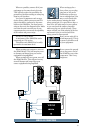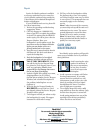
10
PLACEMENT
The SRM350 active speakers are designed
to sit on the floor, a tabletop, or to fit on a
standard tripod speaker stand. They can also
be suspended by the rigging points, which
requires installing the optional hanging
bracket on the top and/or bottom of the
cabinet. NEVER attempt to suspend the
SRM350 active speakers by their handles.
You can lay the cabinet down on its side
and use the SRM350 as a floor monitor. The
asymmetrical trapezoidal shape of the cabinet
provides a perfect angle for aiming up toward
performers from the front of the stage.
As with any powered
components, protect
them from moisture. If
you are setting them up
outdoors, make sure they
are under cover if you expect rain.
The SRM350 generates
magnetic fields. Place it
at least two feet (0.6
meters) or more from
computer monitors.
Check the screen for any change in color or
distortion. Do not place any magnetic audio
or video tapes or computer discs near the
SRM350s.
Room Acoustics
The SRM350 active speakers are de-
signed to sound as neutral as possible; that
is, to reproduce the input signal as accu-
rately as possible, monitoring the sound
rather than changing it.
Room acoustics play a crucial role in the
overall performance of a sound system.
However, the wide high-frequency disper-
sion of the SRM350 helps to minimize the
problems that typically arise.
Balanced XLR Connectors
CONNECTIONS
The SRM350 has a combination female
XLR and 1/4˝ TRS input that accepts a
balanced or unbalanced mic- or line-level
signal. When connecting a balanced signal,
be sure it’s wired per AES (Audio Engi-
neering Society) standards:
XLR TRS
Hot (+) Pin 2 Tip
Cold (–) Pin 3 Ring
Shield (Ground) Pin 1 Shield
There is also a male XLR connector la-
beled THRU. This allows you to connect
more than one SRM350 to the output of
your mixing console. Simply plug the signal
source output into the first INPUT jack,
and patch that speaker’s THRU jack to the
next INPUT jack, and so on, daisy-chaining
multiple speakers (see diagram on page 7).
The THRU jack’s signal
comes after the MIC/LINE
switch, but before the
LEVEL control. If the
MIC/LINE switch is
pushed in on the first
SRM350, the signal at the THRU jack is
boosted by 40 dB to a line level. Therefore,
leave the MIC/LINE switch out on the fol-
lowing SRM350s in the chain.
Top
90
0
Dispersion
u
p
to 20 kHz
90
0
SLEEVE
(SHIELD)
TIPSLEEVE
TIP (HOT)
RING (COLD)
RING
TIP
SLEEVERING
Balanced TRS Connectors


















